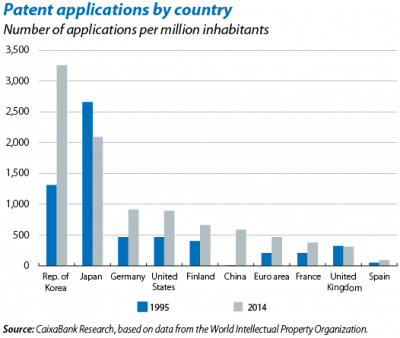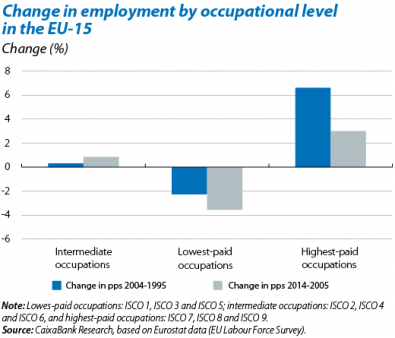How to take advantage of the positive impact of technological change on employment?
At the beginning of the 19th century a group of English tradesmen known as the «Luddites» reacted to the introduction of industrial looms, destroying the machines that threatened to supplant their profession and put lower skilled workers in their place. This instinctive resistance to a rival taking away their work did not succeed: the introduction of looms was delayed for a while but, in the end, technological improvements were implemented.1 Today new technologies are also altering the labour market and a Luddite reaction is not going to stop them. In fact the environment in which this change occurs and how those affected react will influence the scope of this potential growth and how it comes about, especially in the short term. This article analyses how the regulatory framework should be modified to be able to make the most of this potential at the same time as minimising the possible negative effects on the labour market.
Although the implementation of new technologies is beneficial in the long run as they shift the boundaries of production, it also involves a process of adaptation (for more detail see the article «Automation: the dread of workers» in this Dossier). Different elements can help to reduce the time required for society to start using new technologies, in particular the role played by institutions. To maximise the positive impact of new technologies on the labour market, the environment must be such that they can be passed on quickly to the economy and new companies and new jobs be created as a result. This seems to be happening in some countries but not in others: technological advances are being incorporated at differing speeds. Patents provide an example of this: while in Korea there were more than 3,000 patent applications per million inhabitants in 2014, in the euro area these totalled 460 and, in countries such as Spain, fewer than 100. Moreover an innovative firm (for example a new Google) must be able to expand and increase in size: numerous start-ups are created in Europe but few actually grow, either due to a lack of access to capital markets or for other reasons.
To be able to speed up the implementation of new technologies, on the one hand governments could promote essential infrastructures and eliminate institutional barriers to such technologies. In the European case, for example, progress could be made in creating a single digital market that increases the potential benefits of both firms and individuals. The state could also adapt legislation to make it easier to create companies and start-ups, as well as putting more measures in place to ensure that the first companies to arrive do not abuse their excessive market power and block their rivals' entry. It could also help the workforce to have the right skills in order to take advantage of new technologies in the labour market, in particular in tasks that are complementary to those that can be automated, by means of education and training policies (see the article «The unavoidable metamorphosis of the labour market: how can education help?» in this Dossier).
On the other hand, new technologies could potentially have a negative impact in the short term as they directly harm some workers who lose their jobs or see their wages cut due to automation (see the article «Will the Fourth Industrial Revolution come to Spain?» in this Dossier). For these workers it is important to have the right passive and active employment policies in place to mitigate the negative impact and help them find new employment.2 Nevertheless the digital economy has also helped to increase some kinds of work such as part-time workers, freelancers and workers in the gig economy3 (for example Uber). In this respect labour laws must be adapted to cover new employment relations because these are no longer in line with the classic patterns. Harris and Krueger,4 for example, propose a specific status for independent workers in the gig economy who cannot be considered as employees (as they only work when they want) or entirely self-employed (as the company sets the prices and conditions for the service). According to the authors this status would include rights such as belonging to a trade union but not others (minimum wage, unemployment benefit or overtime, which is difficult to calculate) as the workers themselves decide when to work.
Lastly technological advances have also contributed to a significant proportion of the growing polarisation of the labour market by increasing wage dispersion,5 benefitting workers who carry out tasks that are harder to replace or more complementary to these technological advances (and in detriment to those carrying out more repetitive tasks that are therefore easier to automate, normally in intermediate occupations). These technological changes have also increased job opportunities at the two extremes of the distribution of occupations while reducing those in the middle.
As a result, technological change has intensified wage inequality among workers, which could affect the economic growth of developed countries. As countries develop, investment in human capital becomes a more decisive factor in growth (in a similar way investment in physical capital was in the first phases of the development).6 An increase in inequality could therefore lead to under-investment in education by part of the population, which would result in lower aggregate growth7 unless public policies guarantee access to good quality education for the most disadvantaged groups. Given this situation, it is essential that the redistribution of part of the profits generated by technology lead, via public policies, to effective equal opportunities and ensure that no-one is excluded. On the one hand it is necessary to ensure that the tax system continues to produce enough resources to implement such policies. For example, the effects must be examined of a sharp rise in labour market polarisation on tax revenue and the necessary adjustments made to ensure a suitable level of revenue. On the other hand, education and social policies also need to be designed and implemented properly to ensure an adequate investment in the human capital of workers. In any case such systems need to have a thorough assessment system to ensure that they are effective.
Another type of measure to reduce inequality could be aimed at workers becoming shareholders, also owning the profits generated by the technological advances enjoyed by the owners of innovative companies. Kaplan has proposed that the US Government economically incentivise those companies where a large proportion of the shares are listed to bring potential profits within reach of a larger number of individuals,8 although greater stock market capitalisation might not be without its problems as this tends to favour a more short-term view when taking business decisions.
In conclusion, destroying the robot that can automate a job would not be the best solution to a potential loss of employment as, in the long run, technological innovations improve the well-being of the whole of society. However, it is important to decide which public policies are most suitable to ensure that everyone can enjoy such gains.
Josep Mestres Domènech
Macroeconomics Unit, Strategic Planning and Research Department, CaixaBank
1. Their only contribution would be what Hobsbawm called «collective bargaining by riot», a fruitless attempt to secure better wage conditions via multitudinous protests (because the industries are spread throughout the territory).
2. For more details see the Dossier: «Policies to activate the labour market» in MR09/2015.
3. A gig economy refers to those workers applying internet applications created by intermediary firms to look for clients for whom they carry out short-term engagements.
4. Harris, S. and Krueger, A. (2016), «A proposal for modernizing labor laws for the twenty-first-century work: the ‘independent worker'», Policy Brief 2015-10, The Hamilton Project.
5. OECD (2011), «Divided We Stand: Why Inequality Keeps Rising», OECD Publishing, Paris.
6. Galor, O. (2011), «Inequality, Human Capital Formation and the Process of Development», Handbook of the Economics of Education, North Holland.
7. IMF (2014), «Origins and Consequences of Income Inequality: A Global Perspective», IMF Discussion Note 15/13. OECD (2015), «In It Together: Why Less Inequality Benefits All», OECD Publishing, Paris.
8. Kaplan, J. (2015), «Humans Need Not Apply: A Guide to Wealth and Work in the Age of Artificial Intelligence», Yale University Press.






